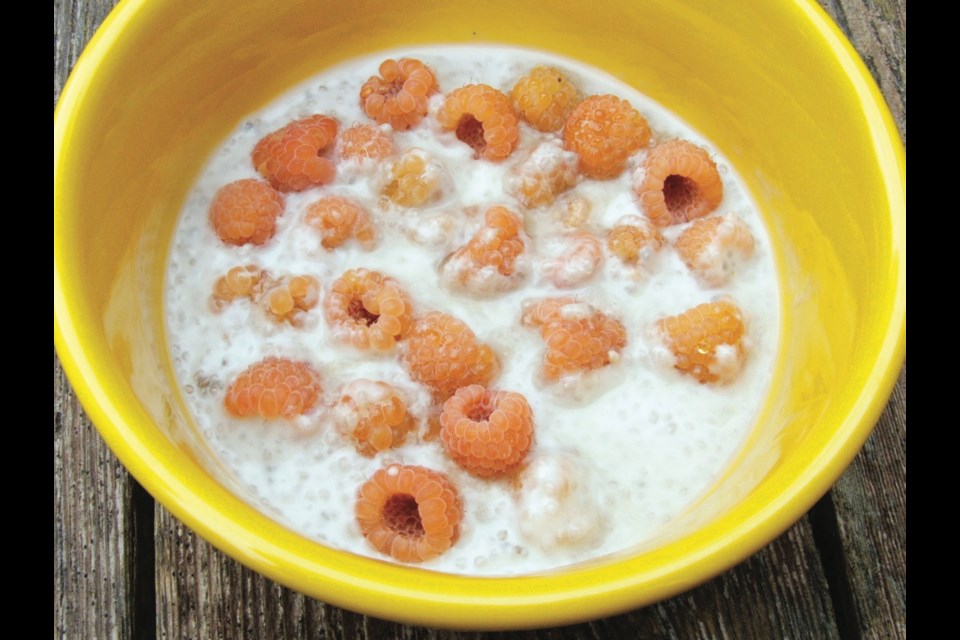As I was gathering raspberries near the back fence recently, my new next-door neighbour came up to the fence to express his delight in a patch of tall, self-sown larkspur that filled an end portion of a plot housing strawberries. Forming a backdrop to the larkspur is a curtain of fig stems bent over with their burden of swelling fruit.
Larkspur, flower of the month for July, is one of those old-fashioned annuals that add a cottage-garden charm to landscapes. They self-sow freely and are beautiful, long-lasting cut flowers. I see bees and butterflies often in the planting. They are a special attractant for bumble bees.
In the language of flowers, larkspur signifies lightness and levity — a reflection perhaps of the light, airy look of the blooms and the feathery foliage. An apt flower with which to celebrate July birthdays, larkspur is also considered to be the flower of sincerity, devotion and attachment.
Larkspur seeds can be sown outdoors early in the spring. Growing them at plot edges where they can be left undisturbed to mature and drop seeds will help to ensure repeat growth and bloom in summers to come.
Thirty-second summer dessert
One of my friends travelled this summer to California for a family wedding. During her stay there, she was introduced to a local coffee shop that featured unusual snacks and sweet treats. She and a relative chose to try a sort of uncooked “pudding” made with coconut milk, chia seeds and berries. She tried it at home and passed the idea along to me. The blend has become a favourite dessert and snack.
It’s absurdly simple. To make a large single serving for myself, I fill an emptied 500-ml yoghurt or sour cream tub half full with coconut milk, and mix in chia seeds to thicken the milk in the fridge overnight.
I have been experimenting with the amount of chia seeds to attain the consistency I want. I have found that about four teaspoons of the nutrient-dense seeds thickens the 250-ml amount of coconut milk to a consistency I like. Some might like it thicker.
The next day, simply add berries or cut fruit to the chia “pudding” for a dessert. Sometimes, I drizzle a little maple syrup or scatter a little coconut sugar over the mix.
This can be a year-round dessert for berry and fruit gardeners, beginning with cut strawberries and followed by raspberries, blueberries and cut plums, figs and kiwis. In winter, I will swirl a homemade fruit sauce into the coconut milk and chia blend. At the moment, I’m using the last container of apple and prune-plum sauce made last summer. Garden fruit sauces such as this are versatile and delicious used as jam, topping for pancakes and puddings and as pie fillings.
It is recommended to use chia seeds only after they have been hydrated. Placing them in a liquid can swell them up to nine times their size in a dry state.
Nasturtiums — again
Because the subject of nasturtiums has come up so often in the mail this spring and early summer, I have been paying closer attention than usual to the plantings in my garden.
As with many home gardeners, I have been growing these cheery, familiar plants for decades. I’m always looking for new varieties and mixtures to try, and often find unusually lovely colour patterns in mixtures. Salt Spring Seeds has a lively blend in orange, yellow, red and peach.
On impulse, at my local Seedy Saturday event early in the year, I bought a nasturtium mix called Jeweled Wonder at the Brother Nature Seeds tables. I had not yet tried seeds from this source, but I will certainly be exploring more of their listings next year. I notice that they list prized heritage annual flowers such as the stunning Grandpa Ott’s morning glory and Naughty Marietta, a personal favourite compact marigold, said to be the oldest available singe-flowered marigold.
The website (brothernature.ca) is nicely set up and easy to use, and they take orders over the phone. The company has an office in Victoria and a heritage, organic farm in the Cowichan Valley.
I planted their nasturtium mix along a pathway edge under a Peaches and Cream honeysuckle trained on wire fencing. The plants have put on an impressive show of colour. The many varied, intricate designs in yellow and orange on the blooms have made the planting a source of ongoing interest.



